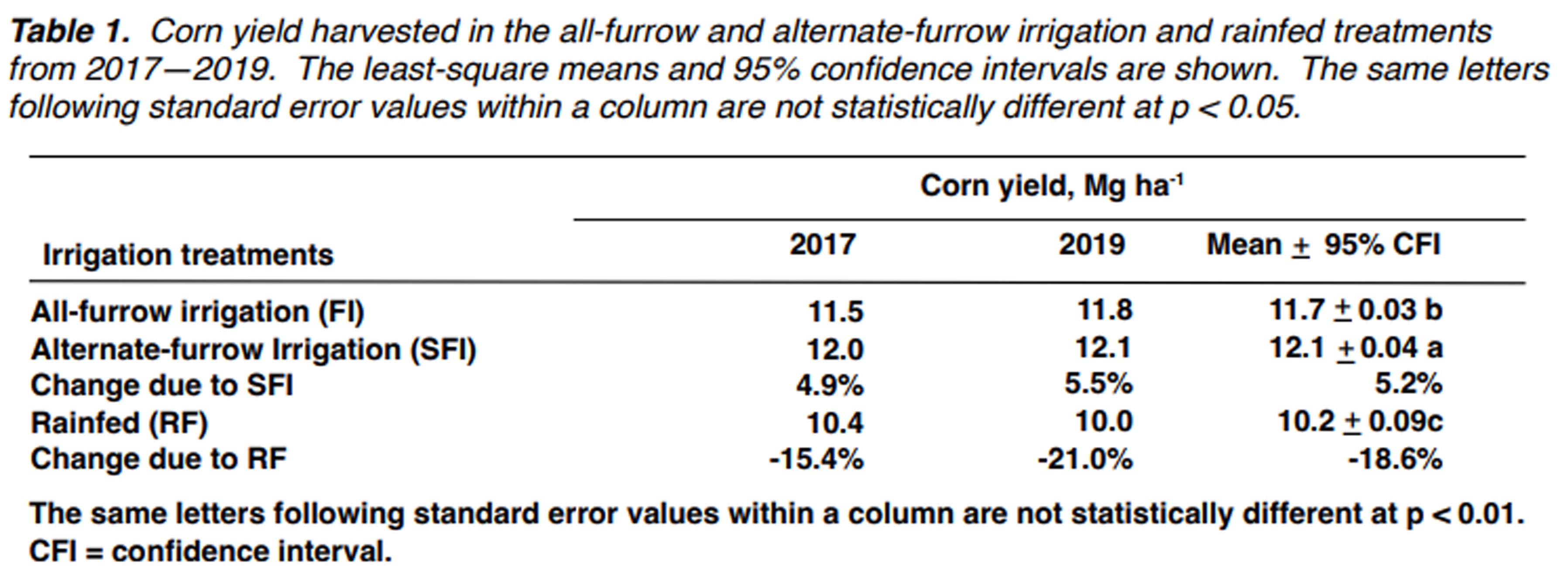Research Project
Skip-row irrigation produces corn yields equal to or better than all-row irrigations in farm-scale experiments
Investigators: Saseendran S. Anapalli and Daryl Chastain
Date: 2022
Project Summary
Introduction
Furrow irrigation, which pumps water from the Mississippi River Valley Alluvial Aquifer (MRVAA), dominates row-crop systems in the Mississippi Delta. The current rate of water removal from the aquifer surpasses natural recharge rates, thus threatening sustainable irrigated agriculture. In this study, corn (Zea mays L.) yield and water use (evapotranspiration; or ET) in all-furrow irrigation (FI), which is the primary irrigation practice, was compared to skip-furrow irrigation (SFI) and rainfed (RF) systems on farm-scale fields (10 ha; 25 ac) in 2017 and 2019 in a clay soil in the Lower Mississippi Delta. ET was monitored using eddy covariance (EC) towers (Figure 1).
Materials and Methods
Farm-scale, on-farm trials provide an opportunity to evaluate irrigation water management technologies under realistic farming conditions. Therefore, this farm-scale experiment allows for researchers to follow the pathway of water from soil- plant- atmosphere at the farmscale. The experiment was a multiyear irrigated corn-soybean rotation conducted between 2016 and 2021 at the USDA-ARS Crop Production Systems Research Unit farm, in Stoneville, Mississippi. This investigation evaluated corn production responses, water use, and ET using cutting-edge science-based Eddy Covariance technology based on FI, SFI, and RF (control) systems. The corn cultivar 'Terral REV Skip-row irrigation produces corn yields equal to or better than all-row irrigations in farm-scale experiments Saseendran S. Anapalli and Daryl Chastain 2022 NCAAR ANNUAL REPORT 35 24BHR99' was planted on 97-cm spaced ridges of about 80 m in a north-south orientation at a seeding rate of about 70,000 seeds ha-1. Intra-row plant spacing on the ridges was about 14 cm. The fertilizer applied was urea ammonium nitrate injected into the ridge base at about 224 kg N ha-1 after corn seedling emergence.
Results and Discussion
Average corn yield in the SFI was significantly (12.1 Mg ha-1) higher (4.9%) than in the FI (11.7 Mg ha-1), with yield in RF (10.2 Mg ha-1) being lower (10.7%) than in the FI. Seasonal average ET was 556, 573, and 540 mm in FI, SFI, and RF, respectively. The average water use efficiencies (WUE) were 0.021, 0.021, and 0.019 Mg ha-1 mm-1, respectively (10.5 % lower in RF than FI and SFI). In the SFI system, the average corn harvested was about 4.3% higher than FI. Grain yield harvested in the RF was approximately 13.7% lower than the FI, emphasizing the importance of irrigating corn in the region for stabilizing yield and economic returns for farmers.
Conclusion
This investigation revealed that adapting the SFI irrigation regime in corn cropping systems could produce grain yields equal to or higher than corn grown under the conventional FI, while saving about 40% of irrigation water. The farm-scale studies conducted in this investigation gave better confidence to recommend SFI to replace traditional FI systems in the region for water conservation in corn cropping systems. Further investigations may be needed to evaluate the viability of SFI in other contrasting soils and climates and recommend the system for adoption by the farming community.
Project Photos

- Topic:
- Irrigation scheduling
- Irrigation
Find Research
By Crop Type
By Topic
Contact NCAAR
General Information
Kaye Sullivan
vfs23@msstate.edu
662.390.8510
F:662.390.8501
Showcase Demo
Drew Gholson, Coordinator
drew.gholson@msstate.edu
662.390.8505
Himmy Lo
himmy.lo@msstate.edu
662.390.8509

